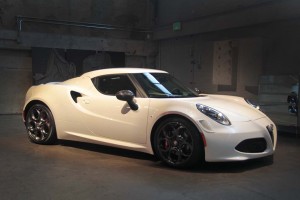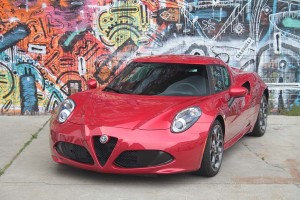It may be a small car but there’s a lot riding on the upcoming launch of the new Alfa Romeo 4C. Marking the brand’s return to the U.S. market after a two-decade absence, the success – or failure – of the two-seat sports car could determine whether the Alfa brand can pull off its ambitious global comeback strategy.
The once-grand marque has become an insignificant player in recent years, but parent Fiat Chrysler Automobiles has approved a 5 billion Euro product development plan that will yield a broad assortment of new models during the next half decade. But as the first offering to reach Alfa’s new U.S. dealer network, it will serve as the foundation for that planned revival, which is expected to see Alfa selling 100,000 cars a year in the U.S. annually before the end of the decade.
“It’s crucial,” Alfa Romeo CEO Harald Wester told TheDetroitBureau.com during a media driving event in San Francisco. “This is the reincarnation of what Alfa stood for in the past,” and what one industry observer described as the “glowing neon sign” that signals what the brand hopes to be in the years ahead.

The first 500 Alfa Romeo 4Cs sold in the U.S. will get the "Launch Edition" moniker, according to the maker.
After years of struggle, Alfa became one of a group of struggling European brands to walk away from the American market in the early 1990s. It didn’t fare much better elsewhere and, over the last several years, officials at Volkswagen AG have expressed interest in buying the Italian maker.
That hasn’t played well with Sergio Marchionne, CEO of Alfa’s parent, Fiat Chrysler Automobiles. If anything, Marchionne has made it clear he intends to give the sporty brand the long-sought resources it needs to become a serious competitor on the global market.
Alfa Romeo plans to use that 5 billion Euro – more than $7 billion – infusion to create an all-new product line-up that will include a mix of two compact models, a midsize and a full-size offering, two crossover-utility vehicles and a “specialty” line.”
Wester and other company officials aren’t providing much in the way of specifics beyond noting that the midsize Alfa will hit the streets in late 2015, about a year after the new 4C goes on sale in the U.S. – it’s already available in Europe.
The company previously confirmed that it is developing a new small car as part of a joint venture with Mazda who will use its version to replace the aging Miata. The Alfa model will share the same basic underpinnings but get its own powertrain, It will also have a slightly larger body, according to Alfa’s chief designer Lorenzo Ramaciotti.
Future Alfa products will follow five key guidelines, said Wester:
- “Advanced and innovative” engines;
- A near 50/50 weight distribution;
- “Unique technical solutions;”
- A high power-to-weight ratio; and
- “Groundbreaking” and “distinctly Italian” design.
The new Alfa Romeo 4C certainly adheres to those rules. It boasts classically Italian curves, the sort of look that had jaded San Franciscans stepping into heavy traffic to snap pics with their smartphones. The two-seater’s carbon fiber monocoque and plastic body panels, meanwhile, helps hold its curb weight to just 2,465 pounds in the U.S. edition, about 300 pounds heavier than the European model. And its pint-sized, 1.75-liter turobocharged inline-four churns out 237 horsepower and 258 pound-feet of torque, massive figures for a vehicle so light.
(Unexpected Canadian election results could be good news for automakers. For more, Click Here.)
At a starting price of $53,900 plus $1,295 in delivery fees, Alfa is hoping to be seen as something of an affordable supercar. (The first 500 cars sold in the U.S. will be Launch Edition models priced at $68,400 plus $1,295 in delivery charges.)
“That will not make Alfa rich,” acknowledged Vester, though if sales hit their target, he suggested, the maker should reach “breakeven” on the project.
(Click Here for details on NHTSA’s new fixation with airbag problems.)
The goal is to deliver about 1,000 copies of the 4C annually in the U.S., which is expected to be the brand’s largest market. China could eventually usurp that role, however. Considering Alfa could barely muster 2,000 sales annually before leaving the market two decades ago, Wester conceded “it will be a challenge” reaching potential buyers in this crowded and competitive market.
Yet, as ambitious as the plans for the 4C might seem, Alfa has even more aggressive aspirations in mind as it rolls out the rest of its planned line-up. Its global target is to top 400,000 sales a year by 2018, up from a mere 74,000 in 2013. The U.S. is expected to generate a quarter of that longer-term demand.
(To see more about GM’s latest four recalls, including 510,000 Camaros, Click Here.)
The maker has already lined up 86 North American dealers, all but four in the U.S. The vast majority currently represent the Fiat brand, but three are Maserati retailers, noted Michael Berube, the North American product planning chief for Alfa. Eventually, the brand hopes to about 300 showrooms in the States.
Considering Alfa’s past problems, it isn’t assured a slam dunk, company officials admit, especially not as tries to carve out a unique niche in a crowded market.
But the initial response to the 4C has been positive. And if this little car can live up to its big expectation, Alfa could be off to a fast start.


It’s not a bad looking car. For the $70K price tag it needs to be bulletproof reliable and deliver on all counts. A Cayman S cost a little less and delivers a lot so there is plenty of competition with a reliable service network to support them.
I don’t disagree. We’ll have a review up shortly.
Paul E.
It turns out that auto.express in the UK has tested the std. Cayman vs. the 4C and on the track the two cars produced identical times – which was a first for their testing. The std. Cayman cost ~$15K less than the Alfa. The Cayman was the clear winner however on many points including steeering, braking, overall refinement, etc. even though it weighs substantially more than the 4C.
My guess is that only Alfa lovers and a few people who want to drive a poor mans Ferrari will buy these. Alfa can and needs to do better to survive. The Cayman S selling for a few thousand less would really trounce the 4C and has Porsche quality and service to back it up.